Cuidados diários que todo dono de gato debe ter
I know caring for a cat can feel overwhelming, so I share my simple daily routine. I set a clear feeding schedule with meal times and portions and track weight to spot changes. I watch hydration, choose the right bowls or a fountain, and do quick checks for dehydration. I keep the litter box fresh with regular scooping and pick the right box and litter to reduce stress. I groom by coat type, check nails, ears, and skin, and use easy tools. I handle dental care and meds with calm steps. I add short play sessions and book vet visits when behavior signs worry me, so my cat stays healthy and happy.
Key takeaway
- Keep fresh water and change it often.
- Feed a healthy diet on a regular routine — choose foods carefully and compare options to match your cat’s needs.
- Brush your cat to reduce hairballs and check skin.
- Play daily to keep your cat fit and happy.
- Visit the vet for checkups and watch for changes.
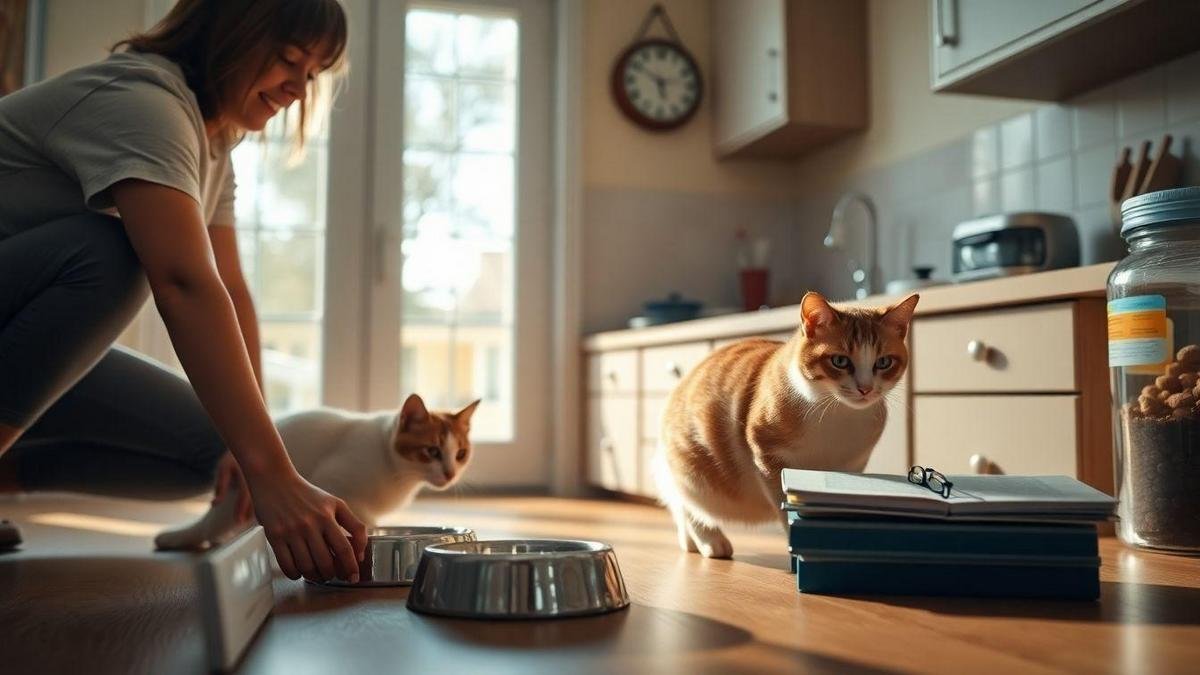
How I set a daily feeding schedule — part of Cuidados diários que todo dono de gato deve ter
I want my cat to feel safe and healthy. I use a simple daily feeding plan that fits our life. I learned by trial and error and share what I do so you can adapt it. This is a key part of the Cuidados diários que todo dono de gato deve ter I follow every day.
How I pick meal times and portions
I feed my cat twice a day — morning and evening. Cats like routine. I keep meals about 10–12 hours apart and adjust portions if she seems hungry or gains weight.
Approximate guide (adjust for age, activity, vet advice):
| Weight (kg) | Daily kcal (approx.) | Example daily portions |
|---|---|---|
| 3 kg | 150 kcal | 50 g wet 15 g dry |
| 4 kg | 200 kcal | 70 g wet 20 g dry |
| 5 kg | 230 kcal | 90 g wet 20 g dry |
Use the food label as a start, then watch your cat for 2–3 weeks. Small changes matter — if you’re comparing brands and ingredients, a guide to premium versus conventional cat food helped me understand trade-offs between cost, ingredients, and caloric density.
Combine feeding with weight monitoring
Weigh your cat once a week on the same scale and time. Record it. I also note food type and grams each day.
Sample tracking table:
| Date | Weight (kg) | Food given (type & g) | Notes |
|---|---|---|---|
| 2025-08-01 | 4.0 | Wet 70g Dry 20g | Active, normal stool |
| 2025-08-08 | 4.1 | Wet 70g Dry 20g | Slightly less active |
If weight moves steadily up or down for 2–3 weeks, adjust portions or ask your vet. Check body shape with your hands — ribs should be felt but not sharp.
Feeding tools and routine
| Tool | Why I use it |
|---|---|
| Kitchen scale | Weigh food in grams for accuracy |
| Measuring scoop | Quick servings when busy |
| Two bowls | One for wet, one for dry |
| Automatic feeder (optional) | Keeps meal times steady |
| Notebook or app | Track weight and food notes |
Daily routine:
- Morning: weigh food, serve, check water.
- Evening: serve, play 10–15 minutes, check litter.
- Weekly: weigh cat and note changes.
The feeding routine is central to good Cuidados diários que todo dono de gato deve ter.
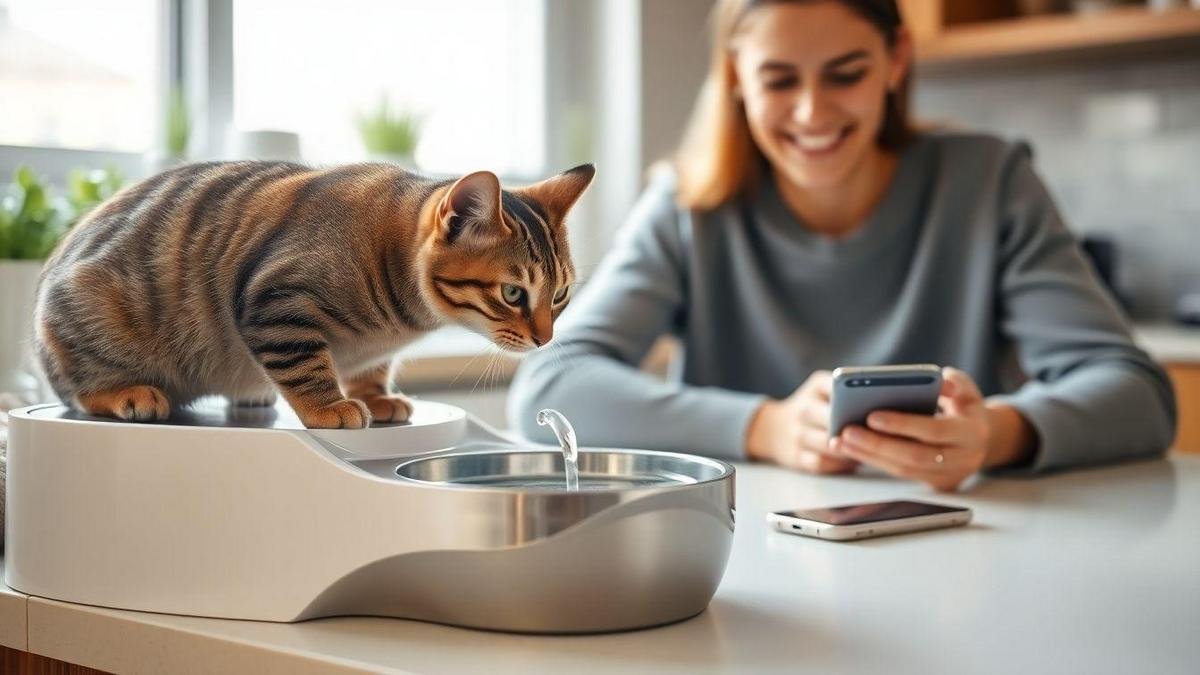
Hydration — an important part of Cuidados diários que todo dono de gato debe ter
Spot dehydration with easy checks
Cats hide sickness well. Watch for these signs of dehydration: low energy, dry gums, reduced urine, and loss of appetite. Quick checks I use:
| Sign to look for | What I do | When to call the vet |
|---|---|---|
| Gums (dry/tacky) | Touch cheek gum gently | If gums are tacky or very dry |
| Skin tent (slow return) | Lift skin over shoulder briefly | If it stays up >2 seconds |
| Eyes (sunken) | Compare to normal | If eyes look hollow or dull |
| Urine output | Watch litter habits | If fewer or darker clumps for 24 hrs |
| Behavior (lethargy, no appetite) | Note activity and eating | If not eating or inactive all day |
If two or more signs appear, call the vet. Aim for roughly 50 ml/kg/day for adults as a rough guide, but track changes rather than exact ml when sick.
Choose water bowls and fountains that encourage drinking
Some cats like moving water, others prefer shallow dishes. I place water away from the litter box and offer 2–3 stations.
| Option | Why I pick it | Care tip |
|---|---|---|
| Stainless steel | Durable, easy to clean | Wash daily with hot soapy water |
| Ceramic | Heavy, less tipping | Check for cracks; clean daily |
| Glass | No odors | Hand wash to avoid chips |
| Water fountain | Encourages sipping | Clean filter and basin twice weekly |
| Wide shallow bowl | Whisker-friendly | Keeps whiskers comfortable |
Daily hydration checklist:
- Check water level in every bowl; top up twice daily if needed.
- Look for signs from the table above.
- Smell and taste the water quickly — no odor.
- Wipe and rinse bowls daily; clean fountains per instructions.
- Count litter box visits roughly — a big drop signals a problem.
- Offer wet food once or twice a day for extra moisture.
Hydration checks are a core part of Cuidados diários que todo dono de gato debe ter.
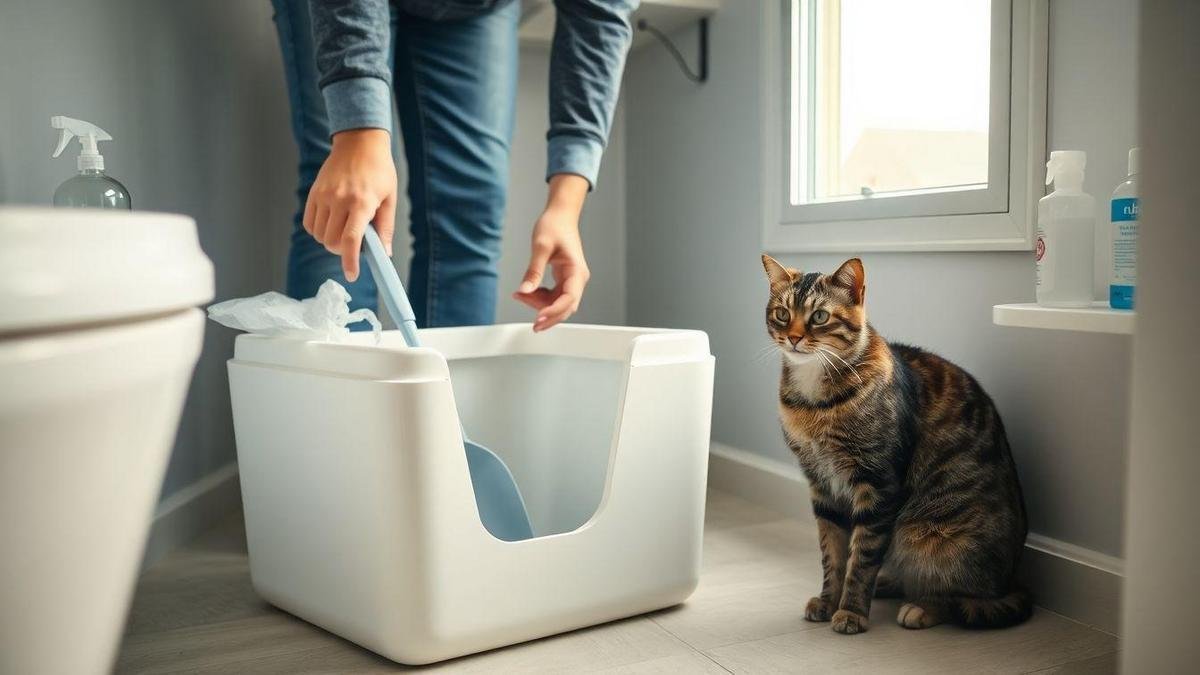
Litter box care — simple steps in your Cuidados diários que todo dono de gato debe ter
Scoop and clean on a schedule
I scoop the box twice a day — morning and night. Deep-clean every two weeks: dump litter, wash with warm water and mild unscented soap, dry, and add fresh litter.
Cleaning schedule:
| Task | Frequency | Why it matters |
|---|---|---|
| Scoop clumps | Twice daily | Keeps box usable and reduces smell |
| Top up litter | Every 2–3 days | Keeps depth comfortable for digging |
| Full litter change wash | Every 2 weeks | Removes buildup and bacteria |
| Replace box | Every 12 months or when cracked | Prevents odor traps and injury |
Pick the right box and litter
Choose a box about 1.5× your cat’s length. Avoid strong scents; many cats dislike perfumes. I use low-dust, unscented clumping litter. If your cat shows avoidance or stress around toileting, practical fixes in preventing litter box avoidance helped me pinpoint placement, box style, and litter texture tweaks.
Litter comparison:
| Litter type | Pros | Cons |
|---|---|---|
| Unscented clumping | Easy to scoop, less smell | Needs regular scooping |
| Silica crystals | Good odor control | Some cats avoid texture |
| Pine/biodegradable | Natural smell | May not clump as well |
Quick daily steps:
- Scoop morning and night.
- Check and remove wet spots right away.
- Top up litter to 4–5 cm depth.
- Wipe rim and nearby floor to keep the area tidy.
- Watch your cat’s habits — skipping the box may mean a problem.
Litter care is a daily pillar of Cuidados diários que todo dono de gato debe ter.
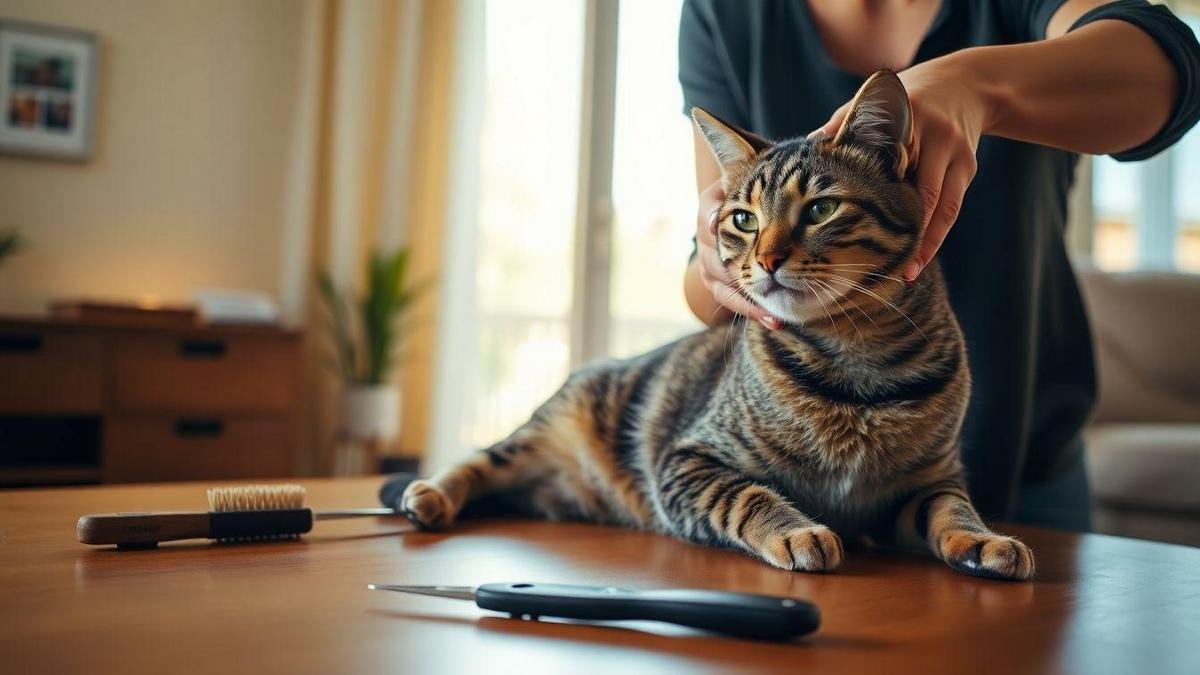
Grooming — daily checks and brushing
I treat grooming as a daily check-in. A few minutes each day keeps fur, skin, and mood in better shape and helps me spot issues early.
Brush by coat type
- Short-haired: brush 2–3× weekly with a soft rubber brush.
- Long-haired: brush daily with a wide-tooth comb then slicker brush; split into short sessions if needed.
- Double-coated: brush once or twice weekly, focus on undercoat.
- Hairless: wipe skin gently with a damp cloth weekly; watch for oil build-up.
Routine: after breakfast works well. Reward with a calm voice or a small treat.
Check nails, ears, and skin
- Check nails weekly; trim if claws catch fabric.
- Inspect ears weekly — they should be pale pink and odorless. Note dark wax or smell.
- Scan skin and fur daily while brushing for bumps, scabs, fleas, or hair loss. Photograph anything odd for the vet.
If you care for a senior cat, gentle grooming and shorter sessions are often best — see tips for handling older cats and ways to entertain seniors without overstimulation.
Grooming gear and frequency:
| Gear | Purpose | Frequency |
|---|---|---|
| Soft rubber brush | Removes loose hair (short coats) | 2–3× weekly |
| Slicker brush | Removes tangles (long fur) | Daily |
| Wide-tooth comb | Finds mats, removes undercoat | As needed |
| Nail clippers | Trim sharp tips | Weekly or biweekly |
| Damp cloth | Wipe skin for hairless cats | Weekly |
| Ear cleaner & cotton | Gentle ear wipe for visible dirt | Weekly/when needed |
Simple steps: calm voice → brush in direction of hair growth → check nails, ears, skin → praise and a tiny treat. These minutes are part of essential Cuidados diários que todo dono de gato debe ter.
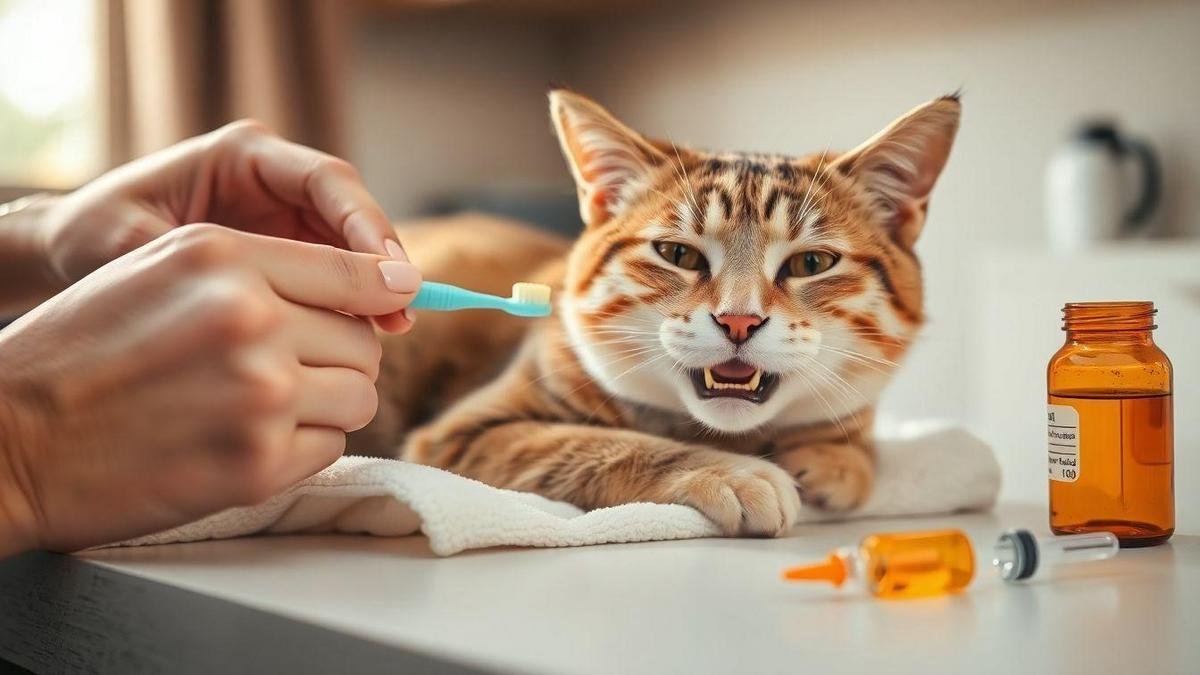
Dental care and medication — calm, consistent steps
Teeth cleaning and dental treats
Start slow. Let your cat sniff the toothbrush and pet toothpaste. I use a finger brush or pet toothbrush with pet-safe toothpaste only. Short sessions (10–20 seconds per cheek) work best; build up gradually.
Tools and use:
| Item | How I use it | Frequency |
|---|---|---|
| Finger brush | Gentle circular strokes on outer teeth | Daily or every other day |
| Pet toothpaste | Small dab on brush | Each brushing |
| Dental treats | After brushing as a reward | 2–3× weekly |
| Water additives | As directed on label | Per product instructions |
Treats help but don’t replace brushing. Call the vet if you see red gums, loose teeth, or heavy bad breath.
Giving pills and following med instructions
Keep calm. Try hiding pills in wet food or a pill pocket. If needed, use the quick pill method: wrap in a towel, open jaw gently, place the pill far back on the tongue, close mouth, and stroke the throat until it swallows. Praise and offer a treat after.
Medication methods:
| Medication type | Method | Notes |
|---|---|---|
| Tablets | Pill pocket or quick pill method | Offer treat after |
| Liquids | Syringe at side of mouth | Go slowly |
| Topical gels | Apply as vet instructed | Wear gloves if needed |
| Compounded/transdermal | Apply where vet shows | Record application time |
Follow vet instructions for dose and schedule. If the cat vomits or seems unwell after a dose, call the vet. Keep a checklist to avoid missed doses.
Compact daily routine:
- Morning: quick mouth check, give meds if scheduled.
- Afternoon: brushing practice or finger rub; refill water.
- Evening: short brushing or dental treat; administer meds if due.
Dental and medication care are integral to Cuidados diários que todo dono de gato debe ter.
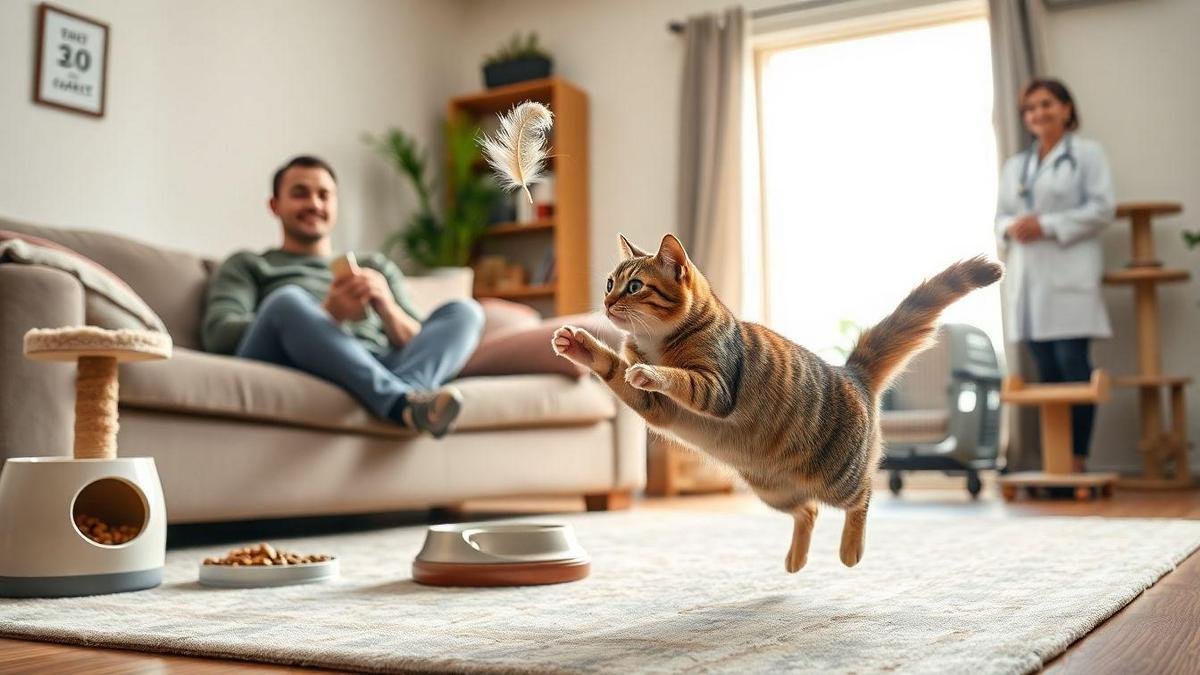
Play, enrichment, and vet checkups
Short, predictable play sessions
Many cats prefer many small sessions. I do 5–10 minute bursts, 3–4 times a day. Rotate toys and hide small treats to keep interest high — rotating between different toy types helped me avoid boredom; resources like recommended indoor toys and ideas on preventing boredom gave practical inspiration. I also use simple DIY setups like tunnels from household items and small puzzle feeders.
Sample play schedule:
| Time | Activity | Purpose | Duration |
|---|---|---|---|
| Morning | Wand toy chase | Stimulate hunting instincts | 5–8 min |
| Midday | Puzzle feeder or treat hide | Mental challenge | 5–10 min |
| Evening | Interactive play cuddle | Burn energy and bond | 8–12 min |
I praise good habits like using scratching posts or puzzle feeders. For vertical enrichment in small spaces, ideas for a multi-level play area, training shelves, or a non-drill window perch made a big difference. For screen-based engagement, brief supervised sessions can work — see tips on using screens for stimulation.
Play and enrichment belong to the list of Cuidados diários que todo dono de gato debe ter.
Weight tracking and vet visits
Weigh your cat monthly at home. I look for changes of 5% over one month or 10% over three months as red flags. Healthy adults get annual checkups; seniors every six months. Move vet visits up if you notice weight loss, appetite drop, or odd bathroom habits.
Weight action guide:
| Change in weight | Action |
|---|---|
| < 5% over 1 month | Watch and recheck next month |
| 5%–10% over 1 month | Call vet, describe changes |
| > 10% over 1–3 months | Book vet visit ASAP |
| Any sudden gain/drop | Contact vet immediately |
Keep vaccine and flea treatment dates in the same notebook or app for quick reminders. If you’re managing life changes (a new apartment, a rescue, or a senior), read practical strategies for supporting newly adopted indoor cats or tips for senior cat care.
Daily behavior signs and when to contact the vet
Watch for:
- Loss of appetite or sudden picky eating.
- Changes in litter box use: straining, more/less often, accidents.
- Unusual lethargy or hiding.
- Changes in grooming: heavy matting or over-grooming.
- Coughing, sneezing, vomiting, or diarrhea lasting more than a day.
If your cat stops eating for 24 hours, loses weight quickly, or shows worrying signs, call the vet and share recent weight logs. Early action helps. Behavioral red flags like clinginess or destructive behavior can sometimes point to separation stress — see guidance on separation anxiety and support.
For safety at home and to reduce accident risk, practical steps in keeping your cat home accident-free and building a safe balcony or window perch are useful complements to vet care. Neutering and routine preventive care also factor into long-term health — see basics on neutering benefits.
Conclusion
It can feel like juggling plates. What keeps me steady is a few simple, repeatable habits: a clear feeding routine, regular weight checks, reliable hydration, tidy litter box care, daily grooming, calm dental and meds steps, short play bursts, and prompt vet checkups. These are the core Cuidados diários que todo dono de gato debe ter.
Small actions, big payoff. I weigh food, top up water, scoop twice daily, brush a little each day, and watch behavior closely. Those tiny checks help me nip problems in the bud before they grow. My cat and I both sleep better when life has a quiet rhythm. When something feels off — loss of appetite, weight shifts, sudden lethargy — I don’t wait. I call the vet and share my notes. Quick action matters.
If you want more practical tips, visit https://blogcraelo.com.
Frequently asked questions
How often should I feed my cat?
Twice a day for most adults. Measure food and watch your cat’s weight and mood.
How do I keep the litter box clean?
Scoop twice daily, deep clean every two weeks, and keep one box per cat plus one spare. For tips on placement and litter choices to avoid avoidance, see preventing litter box avoidance. This is part of Cuidados diários que todo dono de gato debe ter: clean, fresh, simple.
How much play and attention does my cat need?
Short bursts (5–10 min) three to four times a day. Use wand toys and keep sessions fun; curated lists of indoor toys and DIY ideas can help rotate activities.
How often should I groom my cat?
Short-haired: 2–3× weekly. Long-haired: daily. Check for mats, fleas, and sore spots as part of daily Cuidados diários que todo dono de gato debe ter.
When should I call the vet?
Call if your cat stops eating for 24–48 hours, vomits repeatedly, limps, has trouble breathing, or shows sudden changes. Keep regular checkups and vaccinations, and consult resources on supporting newly adopted or senior cats if your situation matches those needs.
Cuidados diários que todo dono de gato debe ter — make these habits part of your everyday routine to keep your cat healthy and happy.






